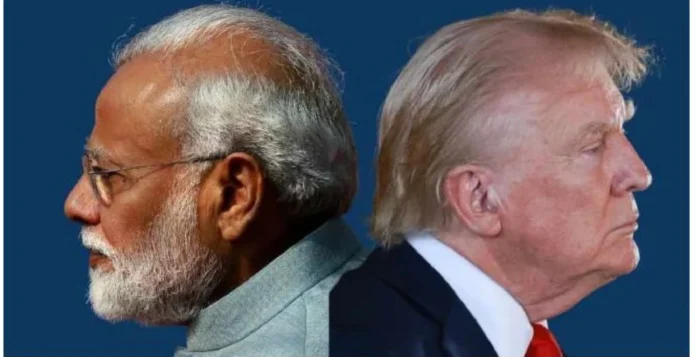By Inderjit Badhwar
The summer of 2025 is shaping up to be one of those inflection points in India’s journey—moments when the tectonic plates of geopolitics shift, demanding that New Delhi recalibrate not just tactics, but the very philosophy of its engagement with the world. The story by Annunthra Rangan is this issue examines that shift in real time, as India confronts a confluence of challenges: a hostile trade environment, a tentative thaw with China, and the broader question of how to preserve sovereignty in a world where alignments are increasingly transactional.
The immediate trigger was Washington’s decision, under President Donald Trump, to impose punitive tariffs on Indian goods. For decades, Indian exports—particularly textiles, pharmaceuticals, chemicals, and gems—have found in the US their most lucrative market. That relationship now stands shaken. By doubling duties to 50 percent, Trump has not just disrupted trade flows worth $87 billion, but also reminded India that even its closest partners can act with cold self-interest. The tariffs threaten millions of livelihoods, especially among small manufacturers in Gujarat, Maharashtra, and Tamil Nadu. Industry associations warn of a 30 percent fall in exports, and economists estimate up to 0.8 percent could be shaved off GDP growth.
Yet what is remarkable is not the scale of the shock, but the resilience of the response. Far from folding under pressure, the Indian government has pledged relief to exporters and accelerated efforts to diversify towards Europe, Africa, ASEAN, and West Asia. Credit agencies, notably Fitch, have kept India’s sovereign rating stable, projecting growth at 6.5 percent in 2025-26. The world, in other words, is betting that India’s domestic dynamism can weather the storm. But resilience is not a strategy; it is only the foundation upon which strategy must be built.
Enter China. The mid-August visit of Foreign Minister Wang Yi to New Delhi—his most consequential engagement since the Galwan clashes of 2020—signalled that Beijing too senses the shifting winds. For the first time in years, the two sides agreed on concrete mechanisms: a new expert group on border delimitation, reopening of border trade posts, the resumption of direct flights, renewed access to Kailash Mansarovar pilgrimages, and even hydrological data-sharing. None of these erase the bitterness of Galwan or the military standoff in Ladakh. But they do mark a cautious reset, a recognition that confrontation serves neither side when both are under external pressure.
For India, the timing could not have been more fortuitous. Just as Washington was closing doors with tariffs, Beijing was opening a window of cooperation—and, strikingly, voicing support for India against US unilateralism. Still, this is no love affair. Trust between India and China is brittle, and New Delhi is clear that normalization cannot mean complacency. The real test will come at the Shanghai Cooperation Organisation summit, where Prime Minister Modi, President Xi, and President Putin will share a stage. It will be the first time in seven years that Modi sets foot in China, and the first bilateral meeting with Xi in nearly two years.
What does all this mean? At one level, it signals India’s determination to keep multiple doors open. At another, it highlights the return—albeit in modern form—of the doctrine of strategic autonomy. This is not the non-alignment of the 20th century, nor the one-sided “natural alliance” with the US that was fashionable in the early 2000s. It is something sharper, more complex: a multi-vector diplomacy that engages Washington on defence and technology, Moscow on energy and security, Beijing on stability and trade, and South Asia on leadership and primacy.
Critics may call it hedging, but hedging is not a weakness when practiced with clarity of purpose. The real danger lies in over-commitment to a single pole. India knows this from history: over-dependence on the Soviet Union in the Cold War, or the West in the early days of liberalisation, left vulnerabilities that could be exploited. Today, the risks are the same, only magnified by global turbulence—from war in Ukraine to instability in West Asia, from climate crises to supply-chain disruptions.
What our story makes clear is that India is not merely reacting; it is reshaping. It is using the tariff shock as an impetus to diversify. It is using a wary dialogue with Beijing to prevent a two-front squeeze. It is using regional initiatives—from naval drills in Sri Lanka to defence credits in Bangladesh—to anchor its primacy in South Asia. Above all, it is reclaiming the agency to say: India will engage with all, but be beholden to none.
This is why the story matters. It is not just about one trade dispute or one summit. It is about how India positions itself in a world that is more fractured than at any time since the Second World War. It is about the art of manoeuvring without being manoeuvred. And it is about the conviction that sovereignty today is measured not only in tanks or tariffs, but in the freedom to choose one’s partners on one’s own terms.
As readers, we invite you to see this story not as a snapshot, but as a compass. It points to where India is headed, and to the choices it must make. The road ahead is fraught, yes. But if India plays this balancing act with wisdom, it may yet transform turbulence into opportunity. That is why this summer, more than any in recent memory, deserves to be remembered as the season when India redefined its place in the world.


